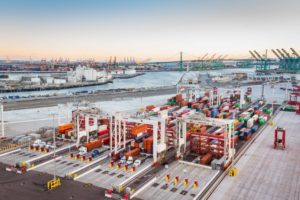Photo: TRAPAC
By Stas Margaronis
After facing losses of U.S. import market share, U.S. West Coast (USWC) ports have increased their import share but lost export market share compared to rival ports on the U.S. Atlantic and Gulf coasts, according to the Pacific Merchant Shipping Association’s West Coast Trade Report.
The June West Coast Trade Report provided April 2021 results as follows:
*USWC ports—big and small— handled 38.9% of all containerized imports through American mainland ports in April: “That was up from 37.5% a year earlier, which was up from 36.8% in April 2019.”
*USWC Ports and the East Asia Trade: “In April, all of the ports in California, Oregon, and Washington handled 56.7% of all containerized imports that arrived from the Far East at U.S. mainland ports. That was up from 54.6% a year earlier and from 56.1% in the first quarter of 2019.”
However, the USWC market share for exports was down:
*USWC ports “handled 34.7% of all containerized export tonnage through U.S. mainland ports down from 37.1% a year earlier and from 36.5% in April of 2019.”
*Export market share to Asia was also down for USWC ports: “… all USWC ports great and small handled 54.4% of all containerized export tonnage bound for the Far East from America’s mainland ports. That was down sharply from 57.6% a year earlier and from a 58.1% share in April of 2019.”
The Port of Los Angeles remained the nation’s leader followed by the Port of Long Beach:
“The Port of Los Angeles was also the nation’s busiest port year-to-date, with 3,539,397 total TEUs through this April. Second was Long Beach with 3,122,315 TEUs, while PNYNJ (Ports of New York and New Jersey) placed third with 2,848,979 TEUs. Savannah handled 1,815,111 total TEUs through April, while the NWSA (Northwest Seaport Alliance-Seattle/Tacoma) ports took care of 1,182,868 loads and empties.”
One of the interesting aspects of the report was that the threat posed to the USWC ports from the Port of Prince Rupert in Canada’s British Columbia appears to have diminished:
“As we noted earlier, Prince Rupert is the only major Pacific Coast port that handled fewer loaded inbound containers through May of this year than it had in the same months a year earlier. That sharply contrasts with the vertigo inducing double-digit year-over-year gains experienced by all of the other major Pacific Coast ports. But that’s not the worst of it. The 222,063 inbound loads the port has handled so far this year is the meagerest inbound total for those months since 2017.”

